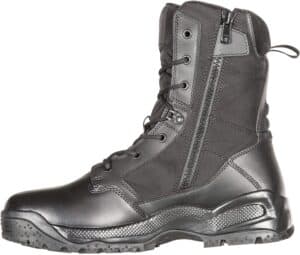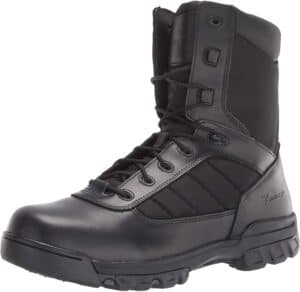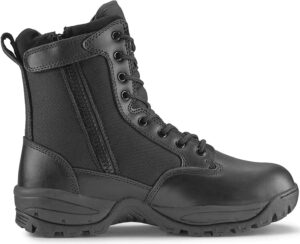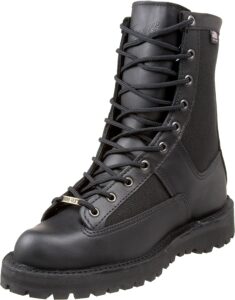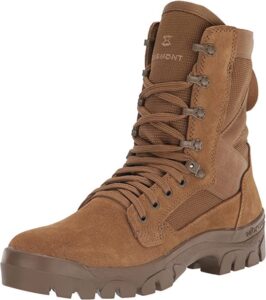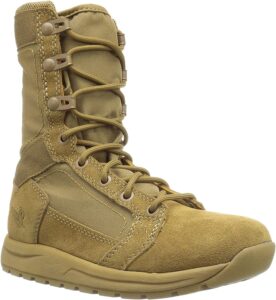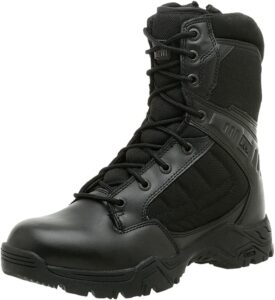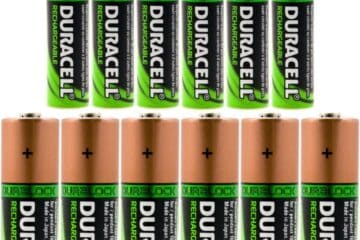Tactical boots are sturdier and more resilient than more standard hiking boots. They’re designed for everything from long hunts in thick country to tactical combat. Even if you don’t necessarily need them for military use, a solid pair of tactical boots is the best way to protect your feet from the harshest of elements.
Our list of the 10 Best Tactical Boots details the features and craftsmanship of the best boots on the market today. Be sure to read on through our Buyer’s Guide for information that will help you select the perfect pair of boots for your needs. Also, our Frequently Asked Questions section addresses some of the more common concerns about selecting, breaking in, and maintaining a pair of tactical boots.
1. 5.11 ATAC Storm
The ATAC Storm from 5.11 has been specifically engineered to provide excellent performance in a broad range of operational environments. It’s a comfortable, durable, and useful tactical boot with a clean, professional profile.
This tactical boot is constructed using leather and Cordura nylon fabric. The 1200-denier Cordura Nylon is used in the boot’s side panels. They also feature triple stitching, prone position grip, antibacterial Drilex lining, and a hidden side pocket.
2. Bates Ultra-Lites
A variety of uniformed personnel has trusted these Bates Ultra-Lites for more than 15 years. Designed to strict Law Enforcement code, these boots built for urban environments with quality leather, 1680-denier ballistic nylon, a flexible athletic construction, and classic styling.
These tactical boots offer a durable and slip-resistant rubber outsole with a cushioned, removable insert. They also boast a side zipper, safety toe, moisture-wicking mesh lining, and a padded tongue and collar for a more comfortable fit.
3. Maelstrom Tac Force
The TAC Force boot is widely trusted by law enforcement, security, and industrial professionals, as well as outdoor enthusiasts. Polishable, full-grain leather and a nylon upper section give these tactical boots a professional look and a comfortable feel. The feature a durable rubber outsole that provides maximum grip on varied terrain, as well as a removable, shock-absorbent cushion insert to guarantee all-day comfort.
Best of all, Maelstrom donates a dollar from every boot they sell to the Boot Campaign, which is a non-profit organization that provides life-improving programs for veterans and military families nationwide.
4. Under Armour Stellar
This is a lightweight boot with a quick-dry, minimalist design. It’s a solid all-purpose tactical boot constructed with durable water repellent treated leather and 900-denier nylon textile upper. The boots boast a rubber sole and polishable toe.
The Under Armour Stellar tactical boots also include anti-odor technology applied to a molded Ortholite (1) sock liner. This liner helps to prevent the growth of odor-causing microbes, which goes a long way when you spend a lot of time in them. They also feature a molded EVA midsole with reinforced TPU shank for added protection and support.
5. Danner Acadia
Made in the USA, the Danner Acadia tactical boot boasts the famous stitch down construction that Danner is known for. These boots provide excellent traction on wet and dry surfaces through the use of a Vibram Kletterlift outsole, which also guarantees better shock absorption.
These boots are made with a combination of full-grain leather and 1000-denier nylon, as well as a waterproof, breathable Gore-Tex lining. They also feature a sleeker and more slender profile and a narrower fit, so these boots are best for those with a more narrow foot.
6. Garmont T8 Bifida
Every Garmont product is backed by years of trailside research into what works best and what is most comfortable. These boots are no exception. They are a heavy duty tactical boot designed with cutting edge materials, functional technologies, and unique innovations.
The Garmont T8 Bifida boasts precise fitting for increased comfort and an improved design that enhances flexibility. They feature a suede finish and, like all Garmont footwear, each feature is included to improve stability, eliminate pressure points, and reduce unnecessary weight.
7. Thorogood Jump Boot
The Thorogood Jump Boot is exactly what you want to have on your feet when responding to an emergency. They are durable, lightweight, and flexible enough to keep up with anything that unfolds on your next shift.
These tactical boots are made with full-grain leather and include a high-shine polishable toecap and an Impact 300 gel heel insert. The boots contain a GENflex2 dual-density rubber outsole with multi-directional traction lugs that increase their resistance on slick surfaces. They also feature a removable, single-density polyurethane footbed with composite shank for added protection and comfort.
8. Under Armour Valsetz RTS
The Valsetz RTS from Under Armour is crafted using lightweight, durable synthetic leather and an updated textile upper. These boots are supportive, comfortable, and offer excellent traction on a variety of surfaces and in inclement conditions.
These tactical boots feature UA’s ClutchFit ankle support system (2), which contours to your foot and provides additional stability where you need it most. They also feature a welded PU film that surrounded the exterior of the boot for increased abrasion resistance. Finally, a molded, antimicrobial Ortholite sock liner helps to keep your feet healthy and your boots smelling fresh.
9. Danner Tachyon
In designing this boot, Danner took their original boot and stripped it of any extra weight. They did this without neglecting the need for comfort and, of course, performance. While most boots in this weight category offer a composite rubber outsole, these include a true rubber outsole that delivers superior abrasion resistance and traction.
The Danner Tachyon tactical boots include completely synthetic leather upper and an open cell, polyurethane footbed. The shank of these boots is made of nylon and they also boast a removable insole. Lastly, these Danner boots feature their speed lacing and 3-layer comfort systems for a snug, comfortable fit.
10. Magnum Response 2
These tactical boots will keep you steady on your feet no matter what the job throws at you. They boast an eight-inch leather and nylon upper that guarantees full foot and ankle protection, as well as a flexible support and abrasion resistance.
Getting in and out of the Magnum Response 2 tactical boots is a breeze with front lacing, a side zipper, and a safety Velcro strap. These boots also feature a moisture-wicking liner to keep your feet dry and a lightly padded heel collar and insole to keep you going all day without fatigue.
—
Buyer’s Guide
Tactical boots were initially created for the armed forces. Since, their use has expanded to include law enforcement personnel, private security, firefighters, hunters, and even the casual outdoor enthusiast. Some of the earliest tactical boots date back to those used by the Roman military, although they were known as “calcei” (3).
Most tactical boots are going to provide more durability and resistance than hiking or trekking boots, but when comparing tactical boots against one another, there can be a lot that separates a good pair from a great one. In this Buyer’s Guide, we will focus on the most important factors you should consider when selecting a new pair of tactical boots.
Your Needs
Deciding on a pair of tactical boots means first being sure that they are the right kind of boots for you. Sometimes a solid pair of hiking boots will do just fine, but in other cases, nothing short of a durable tactical boot will do the job. There are several reasons why you might need tactical boots.
The first reason is that your ankles or knees are either prone to injury or have been injured in the past. The added support of tactical boots significantly reduces the risk or injuring or re-injuring your ankles or knees while wearing them.
The second reason is if you’ll be carrying loads that are quite heavy for your body type. These loads will take a toll on your whole body, but that load will be felt most in your feet, especially if you don’t have the right pair of boots.
The third reason is if you’re a relatively novice outdoorsman (or woman) and the muscles in your legs require a bit of additional support as you train them up. A final reason is if you’ll primarily be using your boots in areas that are also populated by the types of animals with a bite that you want to be sure can’t penetrate your footwear (i.e. snakes).
Durability of Construction
Leather is the most common material used for tactical boots because of its excellent durability and abrasion resistance. More boots these days also include nylon in their uppers. Rubber, on the other hand, is the most common material used in the outsoles of tactical boots.
In general, boots that contain nylon also usually offer more information about the quality of that nylon. A higher denier count in a fabric means that it tends to be thicker, sturdier, and more durable. In addition, rubber outsoles are used due to their superior ability to grip on a variety of terrain, especially in wet conditions.
Comfort
One of the biggest challenges with a new pair of tactical boots is breaking them in. If you’re buying this type of boot, odds are that you’re planning to wear them for long periods at a time. As such, finding a comfortable boot is of the utmost importance.
When selecting a new pair of tactical boots, be sure to look for options that include a cushioned footbed, removable insole, or some form of molded technology. The first will give you an added cushion if your job involves standing for long periods. The second will give you the opportunity to replace with an insole that fits more comfortably to your liking. And the third ensures that the interior of the boot molds to your unique foot style.
As for the break-in process, boots that are crafted with synthetic materials – such as polyester, nylon, and synthetic leather – generally require less time to break in than full-grain or even split-grain leather boots. They can also be cheaper but may wear out faster, so keep that in mind as well.
Water Resistance
A good pair of tactical boots can withstand any set of elements. Full-grain leather is naturally water-resistant, to an extent. Boots made with full-grain leather will keep your feet dry in light rain, but not through a river crossing. Full-grain leather needs to be sprayed by an additional waterproofing substance for added performance.
Some boots offer a waterproof lining that keeps your foot dry even if the exterior of the boot gets wet. The balance you’ll need to find is between waterproofing and breathability, as boots that cause your feet to sweat excessively can essentially have the same effect as those that don’t keep your feet dry when it rains.
Weight
For a boot that you’ll be moving around in a lot, weight really makes a huge difference. A boot that is too heavy will quite literally weigh you down and cause fatigue to set in that much faster. Weight is the one category that can be really easy to overlook when shopping, but that you’ll definitely notice as soon as you take the boots out to break them in.
If you want a boot that’s going to be comfortable and help you perform, look for something that uses lightweight materials in its construction. The catch here is that you want to walk that fine line between lightweight materials and choosing a boot that’s still durable enough to handle the situations you’ll throw at them.
Laces or Zippers
This is a factor that, in most cases, ultimately comes down to your personal preference. However, your occupation may also dictate which type of securing mechanism you prefer. Those that need to make quick footwear changes in an emergency, such as firefighters, will prefer zippers because they’re easier to handle on-the-fly. Laces, on the contrary, tend to be better for military and law enforcement personnel because they provide more adjustment options and won’t come off once securely tied.
Fit
One of the most common mistakes made by first-time buyers is to choose a boot that’s too tight. We tend to think that a tighter boot means your foot will slide around less, thus resulting in fewer hot spots and blisters.
In reality, we have to account for the fact that our feet swell naturally throughout the day. In addition, additional swelling occurs as a result of the stress we put on our feet through the activities we choose. At the end of a long day, you’ll be happy you chose a pair of tactical boots with a little breathing room.
When trying on a potential new pair of tactical boots, make sure to wear the same type of socks you’d normally wear with such footwear. Sock thickness plays a major role in getting the correct boot fit the first time around. Once you put the boots on, take a second before tightening the laces. You should be able to place your index finger between the back of your leg and the back of the boot with very minimal effort.
Next, pay attention to what happens to your foot when you lace the boots up. In a perfect world, you’ll feel your heel moving toward the back of the boot as you tighten. Now it’s time for the old-fashioned ‘walking test’. As you walk around, make sure your toes aren’t touching the front of the boot at all. If it is, this is a major red flag and you should think about sizing up.
Paying attention to your heel as you walk is also important. Ideally, your heel and the back of the boot should move as one. If they rub against each other, you’ll already know the pain and discomfort this can cause down the road. Take that as a warning sign and walk yourself into another size or model.
Lastly, trying shoes on in the late afternoon is the best way to stimulate the natural swelling that occurs in your feet throughout the day. This will give you the best idea of how your potential new tactical boots will feel after a long, full day of use.
Frequently Asked Questions
Modern tactical boots are tough and rugged, but they’re still only as good as the feet inside of them. This Frequently Asked Questions section will answer several of the more common concerns about selecting, breaking in, and maintaining a pair of tactical boots.
Can you explain ‘denier’?
Denier is a unit of measurement relating to the fiber thickness of individual threads or filaments used in the creation of textiles and fabrics. A higher denier count means the fabric is thicker, sturdier, and more durable. A lower count signifies a fabric that is sheer, soft, and silky.
What is the difference between full-grain and split-grain leather?
Full-grain leather is also known as just “leather.” It’s the real deal, 100% leather that offers maximum durability. Its downsides are less breathability and a longer break-in period.
Split-grain leather is a combination of leather and nylon that allows for lighter weight boot construction and increased breathability. Boots made with split-grain leather tend to be a little cheaper, but you’ll sacrifice in the areas of water and abrasion resistance compared to full-grain leather boots.
Is there any way to speed up the break-in process with new boots?
Unfortunately, all the best brands in the tactical boot industry stress the importance of taking it slow when breaking in a new pair of boots. That said, there are two generally accepted methods for breaking in a new pair of tactical boots, the wet method and the dry method. The wet method is the quicker of the two, and we’ll take a moment to briefly outline that process.
Start by filling your boots with warm water. Take enough time to make sure they soak through completely. Next place two pairs of socks on your feet. The best types of socks to use are thin, moisture-wicking, non-cotton types. Socks that absorb too much moisture will extend the time it takes for the boots to dry.
Now empty the water from the boots, put them on, and go about your day. Ideally, go for a long walk or hike. You may need to condition your feet to wear wet boots. To do so, take them off every hour, apply rubbing alcohol to your feet, and put on two fresh pairs of socks. The alcohol helps to toughen your skin and prevent fungal infections.
Every time you feel the leather in the boots loosening, stop and re-lace them. Cinch the boots as often as needed, as tighter boots will form to your feet much faster. At the end of your day, place the boots in front of a fan. This serves to dry any remaining moisture without distorting the mold you’ve formed throughout the day. If the boots have insoles, remove them and dry by the fan also.
Repeat this two or three times and you should notice a significantly more comfortable fit.
What’s the best way to clean my boots?
The best method for cleaning will vary somewhat depending on boot construction. Suede, for example, is averse to liquids. Suede boots are more effectively cleaned using a suede or metal-bristle brush. In conjunction, you can use a damp, soapy cloth to clean the inside of suede boots.
Full-grain leather boots can be cleaned with a regular application of water-based detergent. For a more thorough cleaning, try rubbing saddle soap into the leather with a wet cloth until lather forms. Continue to rub the lather into the boots thoroughly before wiping it off with a clean, damp rag. Finally, let the boots dry and buff them with a soft polishing cloth. The saddle soap serves to ride boots of any accumulated dirt and debris while also setting a nice base for a new coat of polish.
Summary
It’s a really great feeling to know that your feet are secure and protected against the elements. A good pair of tactical boots will give you the sense of a secure foundation that you need to focus on the greater tasks at hand. We hope you’ve enjoyed this list of the best tactical boots and we wish you the best of luck selecting the best pair of boots for your needs!
